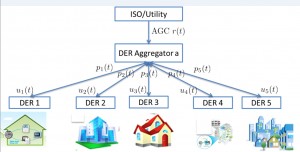Quantifying the Impacts on Reliability of Coupling between Power System Cyber and Physical Components
PhD student Jiangmeng Zhang with advisor A. Domínguez-García
The operation of most modern electrical energy systems is dependent on a cyber infrastructure encompassing sensing, communication, and control devices (cyber components); however, conventional analysis methods are focused on how faults impact the physical infrastructure and are not well equipped to describe the way faults impact the cyber infrastructure that controls the physical infrastructure.
To address this issue, we have quantified an impact in the transmission level on the automatic generation control system. Meanwhile, a high dependency on the cyber infrastructure also appears in the coordination of distributed energy resources (DERs). For instance, as shown in Figure 32, the aggregate coordination (via an aggregator) of DERs, which can provide regulation and load-following services, relies highly on the communication between the aggregator and individual DERs to communicate the measurements (i.e., p(t)’s in Figure 32) and commands (i.e., u(t)’s). While the benefits are relatively well understood, there is virtually no work on understanding the potential negative impact on power system performance due to communication delays or failures. We have provided a systematic method to quantify this impact on distributed systems.
This research is supported by the Trustworthy Cyber Infrastructure for the Power Grid.
